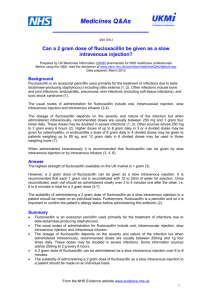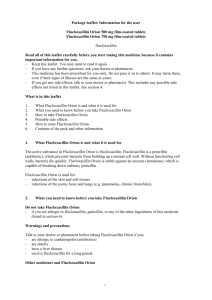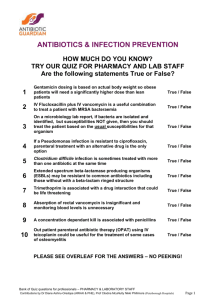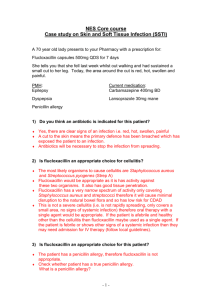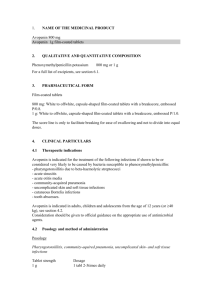Flucloxacillin Orion 500 mg 750 mg film
advertisement
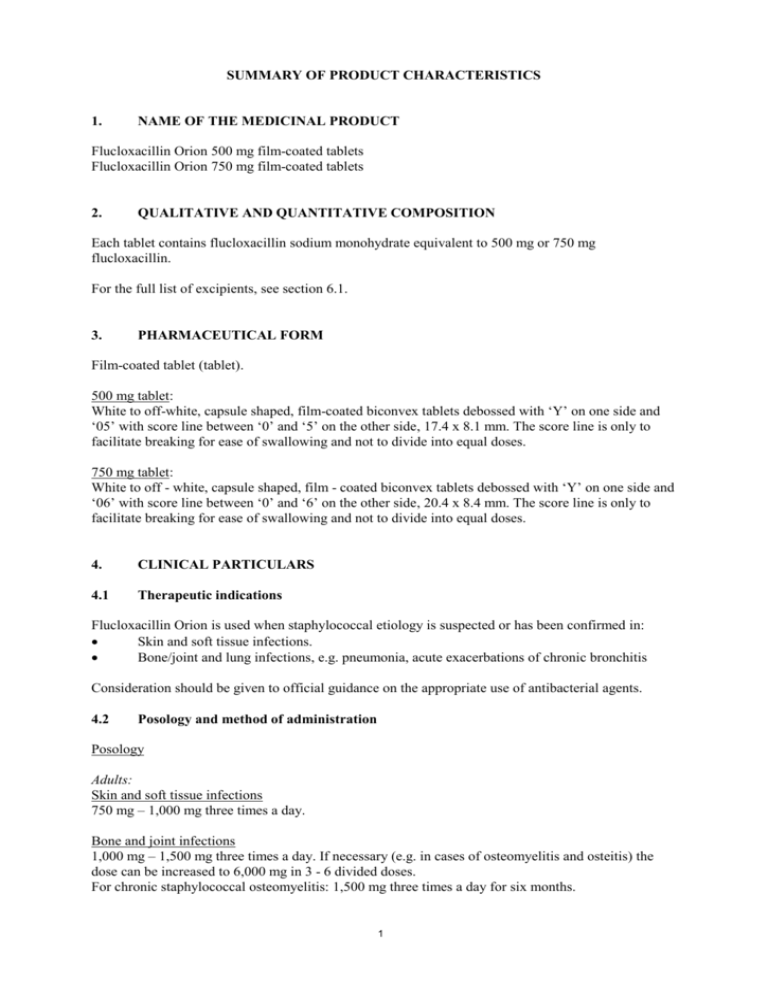
SUMMARY OF PRODUCT CHARACTERISTICS 1. NAME OF THE MEDICINAL PRODUCT Flucloxacillin Orion 500 mg film-coated tablets Flucloxacillin Orion 750 mg film-coated tablets 2. QUALITATIVE AND QUANTITATIVE COMPOSITION Each tablet contains flucloxacillin sodium monohydrate equivalent to 500 mg or 750 mg flucloxacillin. For the full list of excipients, see section 6.1. 3. PHARMACEUTICAL FORM Film-coated tablet (tablet). 500 mg tablet: White to off-white, capsule shaped, film-coated biconvex tablets debossed with ‘Y’ on one side and ‘05’ with score line between ‘0’ and ‘5’ on the other side, 17.4 x 8.1 mm. The score line is only to facilitate breaking for ease of swallowing and not to divide into equal doses. 750 mg tablet: White to off - white, capsule shaped, film - coated biconvex tablets debossed with ‘Y’ on one side and ‘06’ with score line between ‘0’ and ‘6’ on the other side, 20.4 x 8.4 mm. The score line is only to facilitate breaking for ease of swallowing and not to divide into equal doses. 4. CLINICAL PARTICULARS 4.1 Therapeutic indications Flucloxacillin Orion is used when staphylococcal etiology is suspected or has been confirmed in: Skin and soft tissue infections. Bone/joint and lung infections, e.g. pneumonia, acute exacerbations of chronic bronchitis Consideration should be given to official guidance on the appropriate use of antibacterial agents. 4.2 Posology and method of administration Posology Adults: Skin and soft tissue infections 750 mg – 1,000 mg three times a day. Bone and joint infections 1,000 mg – 1,500 mg three times a day. If necessary (e.g. in cases of osteomyelitis and osteitis) the dose can be increased to 6,000 mg in 3 - 6 divided doses. For chronic staphylococcal osteomyelitis: 1,500 mg three times a day for six months. 1 Lung infections Following treatment with a parenteral preparation leading to an improvement in the condition, the infection can continue to be treated with 750 mg flucloxacillin three times a day. Paediatric population Lung infections and skin and soft tissue infections 30-50 mg/kg body weight per day. Example dose: 40 kg: one 500 mg tablet three times a day 50 kg: as adults (750 mg - 1,000 mg three times a day) For children below 40 kg, other medicinal products should be used. Bone and joint infections and severe lung, skin and soft tissue infections The daily dose for children over 2 years old can be doubled, i.e. 60 – 100 mg/kg body weight per day. Method of administration Flucloxacillin Orion produces the best effect if taken between meals. Flucloxacillin Orion tablets have a saliva-resistant coating to protect the normal flora in the oral cavity and throat. 4.3 Contraindications Hypersensitivity to flucloxacillin, penicillin or to any of the excipients listed in section 6.1. 4.4 Special warnings and precautions for use Cross-allergy between penicillins and cephalosporins may occur. Older patients, patients with underlying hepatic disease and those receiving flucloxacillin for longer periods are at greater risk for flucloxacillin induced hepatitis and cholestatic jaundice. In these patients, hepatic events may be severe, and in very rare circumstances, deaths have been reported (see section 4.8). The onset may be delayed for up to 2 months after flucloxacillin treatment has been stopped. Diarrhoea/pseudomembranous colitis caused by Clostridium difficile may occur. Patients with diarrhoea must therefore be closely monitored. 4.5 Interaction with other medicinal products and other forms of interaction The following combinations with Flucloxacillin Orion may require a dose adjustment: contraceptives, methotrexate and warfarin. Certain antibiotics may, in rare cases, reduce the efficacy of the contraceptive pill by interfering with re-absorption of unconjugated steroid in the intestine. This would reduce active steroid plasma levels. Women who have been taking the pill while also being treated with antibiotics, in particular, ampicillin, amoxicillin or tetracyclines, have become pregnant. There is a report describing toxic reaction to methotrexate when the patient was treated with furosemide and penicillin V; organic acids that may compete with the tubular secretion of methotrexate. Suspected interactions have also been reported for the combination of methotrexate with mezlocillin and amoxicillin. 2 There are reports of reduced efficacy of warfarin during concomitant peroral treatment with flucloxacillin. The mechanism is unclear. Probenecid delays renal excretion of flucloxacillin, which can lead to higher serum concentrations of flucloxacillin over a prolonged period. 4.6 Fertility, pregnancy and lactation Pregnancy Clinical data indicates that flucloxacillin does not lead to an increased risk of foetal damage. Animal studies do not indicate congenital malformations. The use of flucloxacillin may be considered during pregnancy, if necessary, but caution should be administered. Breast-feeding Flucloxacillin is excreted in human milk, but at therapeutic doses effects on the breastfed infants are considered unlikely. Nevertheless, potential effects on gastrointestinal and mouth flora, as well as possibility of sensitisation of the infant should be considered. Flucloxacillin can be used during breast-feeding if the benefit to the mother outweighs the risk to the infant. 4.7 Effects on ability to drive and use machines Flucloxacillin Orion has no or negligible influence on the ability to drive and use machines. 4.8 Undesirable effects The most common undesirable effects are gastrointestinal, which occur in approximately 5% of treated patients. Calculated frequencies of undesirable effects are ranked as follows: Very common ((1/10); Common (1/100 to <1/10); Uncommon (1/1,000 to <1/100); Rare (1/10,000 to <1/1,000); Very rare (<1/10,000); not known (cannot be estimated from the available data). Infections and infestations Blood and lymphatic system disorders Rare Uncommon Rare Immune system disorders Gastrointestinal disorders Hepatobiliary disorders Rare Common Rare Skin and subcutaneous tissue disorders Common Uncommon Rare Pseudomembranous colitis Eosinophilia Agranulocytosis, neutropenia Anaphylactic reactions Nausea, diarrhoea Liver injury1), hepatitis, cholestatic jaundice (see section 4.4) Exanthema Urticaria Erythema multiforme, StevensJohnson syndrome, toxic epidermal necrolysis Fungal overgrowth in oral cavity and genitals may occur. 1) Liver injury There is evidence that the risk of flucloxacillin induced liver injury is increased in subjects carrying the HLA-B*5701 allele. Despite this strong association, only 1 in 500-1,000 carriers will develop liver injury. Consequently, the positive predictive value of testing the HLA-B*5701 allele for liver injury is very low (0.12%) and routine screening for this allele is not recommended. Reporting of suspected adverse reactions 3 Reporting suspected adverse reactions after authorisation of the medicinal product is important. It allows continued monitoring of the benefit/risk balance of the medicinal product. Healthcare professionals are asked to report any suspected adverse reactions via the national reporting system listed in Appendix V. 4.9 Overdose Toxicity Large doses are usually well tolerated. Acute reactions mainly arise when there is hypersensitivity. Symptoms Toxic reactions; nausea, vomiting, diarrhoea, electrolyte disorders, impaired consciousness, muscular twitching, myoclonia, convulsions, coma, haemolytic reactions, renal failure and acidosis. In exceptional instances, anaphylactic shock can occur within 20 - 40 minutes. Management If justified, gastric lavage, charcoal. Symptomatic treatment. In severe cases, haemoperfusion or haemodialysis. Treatment for anaphylactic reaction: Epinephrine (adrenaline) 0.1 - 0.5 mg slow intravenous, hydrocortisone 200 mg intravenous, possibly promethazine 25 mg intravenous, fluids, acidosis correction. 5. PHARMACOLOGICAL PROPERTIES 5.1 Pharmacodynamic properties Pharmacotherapeutic group: Antibacterials for systemic use, beta-lactamase-resistant penicillins. ATC code: J01CF05. Mechanism of action Flucloxacillin belongs to the group isoxazolyl penicillins, which exhibit activity against betalactamase-producing staphylococci. Flucloxacillin works by inhibiting bacterial cell wall synthesis and has a bactericidal effect. Pharmacokinetic/pharmacodynamic relationship The antibacterial effect of flucloxacillin is best correlated to the time when the concentration of antibiotics exceeds MIC. Mechanism of resistance Resistance to isoxazolyl penicillins (‘methicillin resistance’) is caused by the bacteria producing an altered penicillin-binding protein. Cross-resistance arises within the beta-lactam group (penicillins and cephalosporins). Methicillin-resistant staphylococci generally are resistant to all beta-lactam antibiotics. Susceptibility testing breakpoints MIC breakpoints for flucloxacillin according to the European Committee on Antimicrobial Susceptibility Testing (EUCAST) Version 1.1 Bacteria species Susceptibility breakpoints (MIC) mg/l Susceptible ≤ Resistant > 0.12 0.12 0.25 0.25 Staphylococcus spp. Streptococcus groups A,B, C and G 1) 4 1) The beta-lactam susceptibility of beta-haemolytic streptococcus groups A, B, C and G is inferred from the penicillin susceptibility. Antibacterial spectrum The prevalence of acquired resistance may vary geographically and with time for selected species, and local information on resistance is desirable, particularly when treating severe infections. As necessary, expert advice should be sought when the local prevalence of resistance is such that the utility of the agent in at least some types of infections is questionable. Commonly susceptible species Staphylococcus aureus, methicillinsusceptible Streptococci especially group C and G and Streptococcus pyogenes Species for which acquired resistance may be a problem Coagulase-negative staphylococci Resistant organisms Methicillin-resistant staphylococci Enterococci Gram-negative bacteria Anaerobic bacteria Clostridium difficile Streptococci and pneumococci are more susceptible to benzylpenicillin (penicillin G) and phenoxymethylpenicillin (penicillin) V than to flucloxacillin. Liver injury There is evidence that the risk of flucloxacillin induced liver injury is increased in subjects carrying the HLA-B*5701 allele. Despite this strong association, only 1 in 500-1,000 carriers will develop liver injury. Consequently, the positive predictive value of testing the HLA-B*5701 allele for liver injury is very low (0.12%) and routine screening for this allele is not recommended. 5.2 Pharmacokinetic properties Flucloxacillin is well absorbed after peroral administration. Administration with meals has a negative effect on absorption. The biological half-life in serum is approx. 80-90 minutes and binding to serum proteins amounts to 94-95%. Of the various isoxazolyl penicillins, flucloxacillin produces the highest proportion of free (non-protein-bound) penicillin in serum. Elimination of flucloxacillin occurs mainly through the kidneys via tubular secretion and glomerular filtration. Within 6 hours, approx. 50-55% of a peroral dose is excreted in the urine. 5.3 Preclinical safety data There is no further preclinical data of relevance for the safety assessment other than the information already included in this summary of product characteristics. 6. PHARMACEUTICAL PARTICULARS 6.1 List of excipients Tablet core: Magnesium stearate 5 povidone croscarmellose sodium microcrystalline cellulose Film-coat: Titanium dioxide (colour E171) hypromellose Macrogol 6000 paraffin light, -liquid 6.2 Incompatibilities Not applicable. 6.3 Shelf life 2 years. 6.4 Special precautions for storage This medicinal product does not require any special storage conditions. 6.5 Nature and contents of container The package consists of a white opaque round HDPE container closed with white opaque polypropylene closure having induction sealing liner. Each HDPE container contains sachet(s) as desiccant. 500 mg film-coated tablets 30, 50 and 100 tablets 750 mg film-coated tablets 20, 30, 50 and 100 tablets Not all pack sizes may be marketed. 6.6 Special precautions for disposal and other handling No special requirements. 7. MARKETING AUTHORISATION HOLDER Orion Corporation Orionintie 1 FI-02200 Espoo Finland 8. MARKETING AUTHORISATION NUMBER(S) To be completed nationally. 9. DATE OF FIRST AUTHORISATION/RENEWAL OF THE AUTHORISATION Date of first authorisation: 6 Date of latest renewal: To be completed nationally. 10. DATE OF REVISION OF THE TEXT 2015-10-23 7
